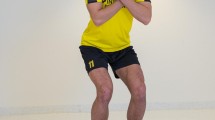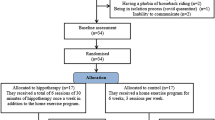Abstract
Objective
A substantial number of individuals present with prolonged symptoms after a mild traumatic brain injury (mTBI) or concussion. This has warranted the development of assessment tools that can reliably detect prolonged symptoms after an mTBI. At present, a gold standard diagnostic tool for accurately identifying such prolonged symptoms is not available. The purpose of this study is to utilize specific measures of standing balance, cognitive function, and bimanual coordination to examine persisting long-term deficits in individuals with mTBI.
Methods
A total of 18 (medically diagnosed with an mTBI within the last year) and 14 (healthy age-matched controls) individuals participated in the study. Assessment tools included NIH Toolbox Cognition Battery (NIHTB-CB), TEMPA, and Purdue pegboard (bimanual coordination) and standing balance on a force platform.
Results
Individuals with mTBI demonstrated lower scores in all measures of cognition with statistically significant difference (p = 0.03) in executive function. The clinical tests of bimanual coordination did not show any statistically significant differences between groups. Postural stability was significantly reduced (p = 0.039) in the mTBI group.
Conclusion
Our results show long-term performance deficits (cognition and postural stability) that persist in individuals with mTBI. In addition, to the best of our knowledge, this is the first study to identify cognitive deficits in individuals with mTBI by utilizing NIHTB-CB. Knowledge gained from this study might affect decisions of return-to-play or return-to-learn in individuals with a history of mTBI(s).


Similar content being viewed by others
References
Carroll LJ, Cassidy JD, Holm L, Kraus J, Coronado VG, WCCTF on MTBI (2004) Methodological issues and research recommendations for mild traumatic brain injury: the WHO collaborating centre task force on mild traumatic brain injury. J Rehabil Med:113–125
Gerberding JL BS (2003) Report to congress on mild traumatic brain injury in the United States: steps to prevent a serious public health problem. Centers dis control Prev 9–11
Alexander MP (1995) Mild traumatic brain injury: pathophysiology, natural history, and clinical management. Neurology. https://doi.org/10.1212/WNL.45.7.1253
Lange RT, Brickell TA, Iverson GL, Parkinson G, Bhagwat A, FLM (2011) 12-month outcome of mild traumatic brain injury and polytrauma in U.S. military service members. In: Coping with Blast-Related Traumatic Brain Injury in Returning Troops, pp 171–186
Caplain S, Blancho S, Marque S et al (2017) Early detection of poor outcome after mild traumatic brain injury: predictive factors using a multidimensional approach a pilot study. Front Neurol. https://doi.org/10.3389/fneur.2017.00666
(2015) Traumatic Brain Injury Hope Through Research. NIH Publ. No. 15–2478
Halstead ME, Walter KD (2010) Sport-related concussion in children and adolescents. Pediatrics. https://doi.org/10.1542/peds.2010-2005
Buckley TA, Baugh CM, Meehan WP, Difabio MS (2017) Concussion management plan compliance a study of NCAA power 5 conference schools. Orthop J Sport Med. https://doi.org/10.1177/2325967117702606
jcoleman@ncaa.org (2014) Concussion diagnosis and management best practices. In: NCAA.org - Off. Site NCAA
Okie S (2005) Traumatic brain injury in the war zone. N Engl J Med. https://doi.org/10.1056/NEJMp058102
(2016) DoD Worldwide Numbers for TBI. In: DVBIC
(2016) VA/DoD Clinical practice guideline for the management of concussion-mild traumatic brain injury
Belanger HG, Vanderploeg RD, Curtiss G, Warden DL (2007) Recent neuroimaging techniques in mild traumatic brain injury. J Neuropsychiatr Clin Neurosci 19:5–20. https://doi.org/10.1176/appi.neuropsych.19.1.5
Kinnunen KM, Greenwood R, Powell JH et al (2011) White matter damage and cognitive impairment after traumatic brain injury. Brain. https://doi.org/10.1093/brain/awq347
Berman RA, Colby CL, Genovese CR, Voyvodic JT, Luna B, Thulborn KR, Sweeney JA (1999) Cortical networks subserving pursuit and saccadic eye movements in humans: an FMRI study. Hum Brain Mapp 8:209–225. https://doi.org/10.1002/(SICI)1097-0193(1999)8:4<209::AID-HBM5>3.0.CO;2-0
Serrien DJ, Nirkko AC, Wiesendanger M (2001) Role of the corpus callosum in bimanual coordination: a comparison of patients with congenital and acquired callosal damage. Eur J Neurosci 14:1897–1905. https://doi.org/10.1046/j.0953-816X.2001.01798.x
Degani AM, Santos MM, Leonard CT, Rau TF, Patel SA, Mohapatra S, Danna-Dos-Santos A (2017) The effects of mild traumatic brain injury on postural control. Brain Inj 31:49–56. https://doi.org/10.1080/02699052.2016.1225982
Dash PK, Zhao J, Hergenroeder G, Moore AN (2010) Biomarkers for the diagnosis, prognosis, and evaluation of treatment efficacy for traumatic brain injury. Neurotherapeutics 7:100–114. https://doi.org/10.1016/j.nurt.2009.10.019
Prince C, Bruhns ME (2017) Evaluation and treatment of mild traumatic brain injury: the role of neuropsychology. Brain Sci
Iverson GL, Lovell MR, Collins MW (2003) Interpreting change on ImPACT following sport concussion. Clin Neuropsychol (neuropsychology, Dev Cogn sect D). https://doi.org/10.1076/clin.17.4.460.27934
Buzzini SRR, Guskiewicz KM (2006) Sport-related concussion in the young athlete. Curr Opin Pediatr
Tulsky DS, Carlozzi NE, Holdnack J, Heaton RK, Wong A, Goldsmith A, Heinemann AW (2017) Using the NIH toolbox cognition battery (NIHTB-CB) in individuals with traumatic brain injury. Rehabil Psychol 62:413–424. https://doi.org/10.1037/rep0000174
Korman C (USA T (2017) The NFL’s concussion protocol failed Cam Newton
Michael Hurley CB (2017) Hurley: tom savage becomes latest glaring failure of NFL’s concussion protocol
McCrory P, Meeuwisse W, Dvořák J et al (2017) Consensus statement on concussion in sport—the 5th international conference on concussion in sport held in Berlin, October 2016. Br J Sports Med. https://doi.org/10.1136/bjsports-2017-097699
McAllister TW, Ford JC, Ji S et al (2012) Maximum principal strain and strain rate associated with concussion diagnosis correlates with changes in corpus callosum white matter indices. Ann Biomed Eng. https://doi.org/10.1007/s10439-011-0402-6
Wortzel HS, Arciniegas DB (2012) Treatment of post-traumatic cognitive impairments. Curr Treat Options Neurol 14:493–508. https://doi.org/10.1007/s11940-012-0193-6
Weintraub S, Dikmen SS, Heaton RK, Tulsky DS, Zelazo PD, Bauer PJ, Carlozzi NE, Slotkin J, Blitz D, Wallner-Allen K, Fox NA, Beaumont JL, Mungas D, Nowinski CJ, Richler J, Deocampo JA, Anderson JE, Manly JJ, Borosh B, Havlik R, Conway K, Edwards E, Freund L, King JW, Moy C, Witt E, Gershon RC (2013) Cognition assessment using the NIH toolbox. Neurology 80:S54–S64. https://doi.org/10.1212/WNL.0b013e3182872ded
Moseley AM, Yap MC (2003) Interrater reliability of the TEMPA for the measurement of upper limb function in adults with traumatic brain injury. J Head Trauma Rehabil 18:526–531
Desrosiers J, Hébert R, Bravo G, Dutil E (1995) The Purdue Pegboard Test: normative data for people aged 60 and over. Disabil Rehabil 17:217–224. https://doi.org/10.3109/09638289509166638
Ghawami H, Sadeghi S, Raghibi M, Rahimi-Movaghar V (2017) Executive functioning of complicated-mild to moderate traumatic brain injury patients with frontal contusions. Appl Neuropsychol. https://doi.org/10.1080/23279095.2016.1157078
Kumar S, Rao SL, Chandramouli BA, Pillai S (2013) Reduced contribution of executive functions in impaired working memory performance in mild traumatic brain injury patients. Clin Neurol Neurosurg. https://doi.org/10.1016/j.clineuro.2012.12.038
Okonkwo DO, Tempel ZJ, Maroon J (2014) Sideline assessment tools for the evaluation of concussion in athletes: a review. [miscellaneous article]. Neurosurgery. https://doi.org/10.1227/NEU.0000000000000493
Alsalaheen B, Stockdale K, Pechumer D, Broglio SP (2016) Validity of the immediate post concussion assessment and cognitive testing (ImPACT). Sport. Med
Caeyenberghs K, Leemans A, Coxon J, Leunissen I, Drijkoningen D, Geurts M, Gooijers J, Michiels K, Sunaert S, Swinnen SP (2011) Bimanual coordination and corpus callosum microstructure in young adults with traumatic brain injury: a diffusion tensor imaging study. J Neurotrauma 28:897–913. https://doi.org/10.1089/neu.2010.1721
Jantzen KJ, Anderson B, Steinberg FL, Kelso JAS (2004) A prospective functional MR imaging study of mild traumatic brain injury in college football players. Am J Neuroradiol
Kuhtz-Buschbeck JP, Hoppe B, Gölge M, Dreesmann M, Damm-Stünitz U, Ritz A (2003) Sensorimotor recovery in children after traumatic brain injury: analyses of gait, gross motor, and fine motor skills. Dev Med Child Neurol 45:821–828. https://doi.org/10.1017/S001216220300152X
Platz T, Winter T, Muller N et al (2001) Arm ability training for stroke and traumatic brain injury patients with mild arm paresis: a single-blind, randomized, controlled trial. Arch Phys Med Rehabil 82:961–968. https://doi.org/10.1053/apmr.2001.23982
De Beaumont L, Mongeon D, Tremblay S et al (2011) Persistent motor system abnormalities in formerly concussed athletes. J Athl Train 46:234–240. https://doi.org/10.4085/1062-6050-46.3.234
Thompson L, Badache M, Cale S et al (2017) Balance performance as observed by center-of-pressure parameter characteristics in male soccer athletes and non-athletes. Sports. https://doi.org/10.3390/sports5040086
Cavanaugh JT, Guskiewicz KM, Giuliani C et al (2005) Detecting altered postural control after cerebral concussion in athletes with normal postural stability. Br J Sports Med. https://doi.org/10.1136/bjsm.2004.015909
Baracks J, Casa DJ, Covassin T et al (2018) Acute sport-related concussion screening for collegiate athletes using an instrumented balance assessment. J Athl Train. https://doi.org/10.4085/1062-6050-174-17
Quatman-Yates CC, Bonnette S, Hugentobler JA, et al (2015) Postconcussion postural sway variability changes in Youth: The Benefit of Structural Variability Analyses. Pediatr Phys Ther. https://doi.org/10.1097/PEP.0000000000000193
Karr JE, Areshenkoff CN, Garcia-Barrera MA (2014) The neuropsychological outcomes of concussion: a systematic review of meta-analyses on the cognitive sequelae of mild traumatic brain injury. Neuropsychology. https://doi.org/10.1037/neu0000037
Belanger HG, Spiegel E, Vanderploeg RD (2010) Neuropsychological performance following a history of multiple self-reported concussions: a meta-analysis. J Int Neuropsychol Soc. https://doi.org/10.1017/S1355617709991287
Funding
The authors would like to thank the University of Vermont, Office of the Vice President for Research, Express Grant program (PI: Mohapatra) Grant Program, for funding this study.
Author information
Authors and Affiliations
Corresponding author
Ethics declarations
Conflict of interest
The authors declare that they have no conflict of interests.
Additional information
Publisher’s note
Springer Nature remains neutral with regard to jurisdictional claims in published maps and institutional affiliations.
Rights and permissions
About this article
Cite this article
Kunker, K., Peters, D.M. & Mohapatra, S. Long-term impact of mild traumatic brain injury on postural stability and executive function. Neurol Sci 41, 1899–1907 (2020). https://doi.org/10.1007/s10072-020-04300-0
Received:
Accepted:
Published:
Issue Date:
DOI: https://doi.org/10.1007/s10072-020-04300-0




